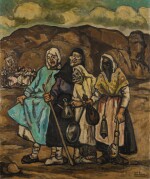19th Century European Paintings
19th Century European Paintings

JOSÉ GUTIÉRREZ SOLANA | Carnaval
Auction Closed
December 11, 03:18 PM GMT
Estimate
60,000 - 80,000 GBP
Lot Details
Description
JOSÉ GUTIÉRREZ SOLANA
Spanish
1886 - 1945
Carnaval
signed J. Solana lower right
oil on canvas
90 by 75cm., 35½ by 29½in.
Alvaro Gil Varela, Lugo (acquired from the artist)
Juan Rof Carballo, Madrid
Galería Biosca, Madrid
Private collection, Spain (purchased from the above in 1985; sale: Sotheby's, London, 22 May 2014, lot 16)
Purchased at the above sale by the present owner
Solana. Oleos, Museo Carlos Maside, Sada-El Castro-La Coruña, 1977
José Luis Barrio Garay, Solana, London-New York, 1978, fig. 271 (as Cuatro Máscaras)
Luis Alonso Fernández, J. Solana. Estudio y Catalogación de su obra, Madrid, 1985, p. 265, no. P. 304, catalogued & illustrated
Painted circa 1943.
Solana’s paintings at once satirise and celebrate the rites and rituals of the rural communities of Santander and Castille. By focusing on the fanciful, the hysterical, the grotesque, and the macabre, Solana emphasises the bleak provinciality that isolated Spain from modern Europe following the loss of its colonial possessions and status as a world power at the end of the nineteenth century. Conversely, Solana - like the patriotic intellectuals of the Generación de 98 who called for the regeneration of Spain and with whom he fraternised - in his work implies that the country’s future is founded upon its proud traditions and the patriotism of its people.
Born on Carnival Sunday in Madrid in 1886, Solana was predestined to have a fascination with processions and grotesque masks. His highly personal aesthetic was informed not only by the Spanish Old Masters and notably Goya (whose Burial of the Sardine served as the direct inspiration for the present work); but by wider European artistic currents. Like the Belgian Symbolist and Realist artist James Ensor, whose works he would have known through their mutual friend Darío de Regoyos, masks allowed Solana to remove himself and his art from the political statement that underlies so many of his paintings.
